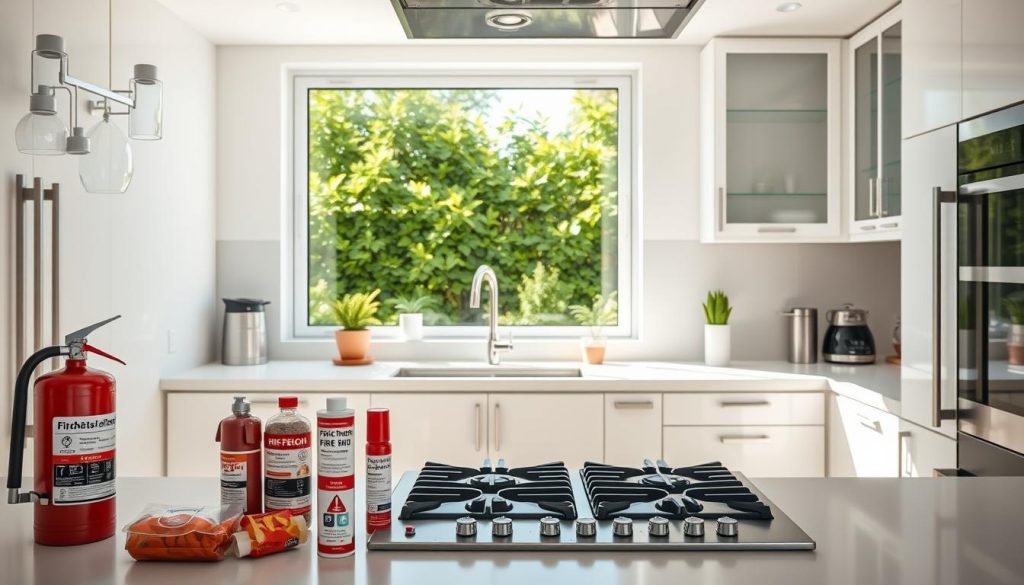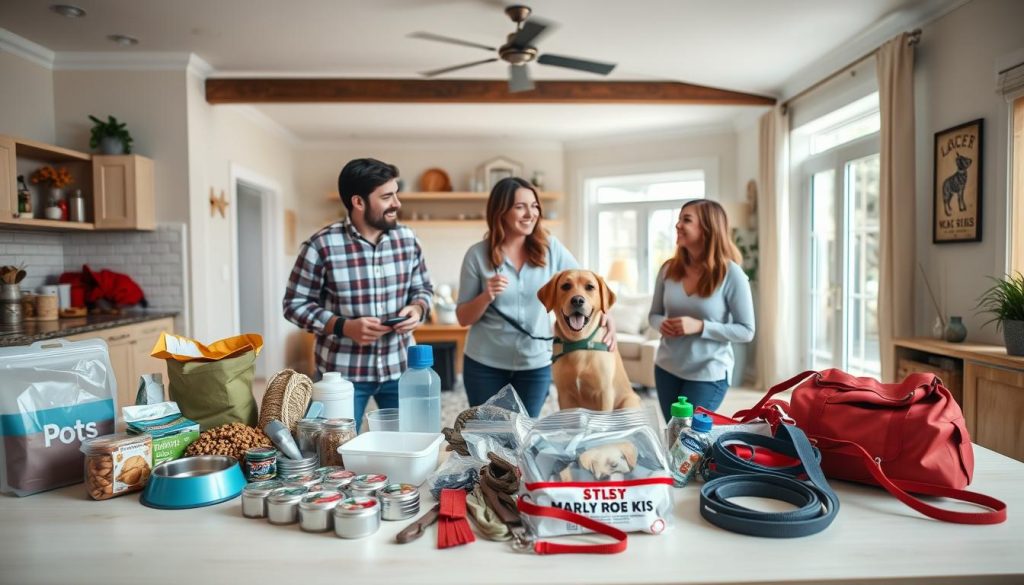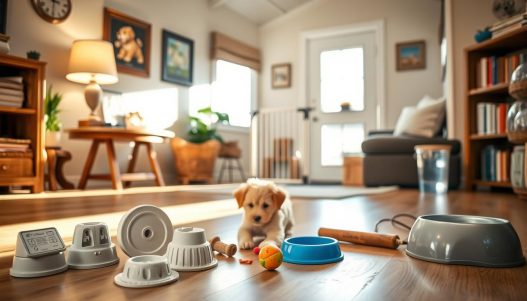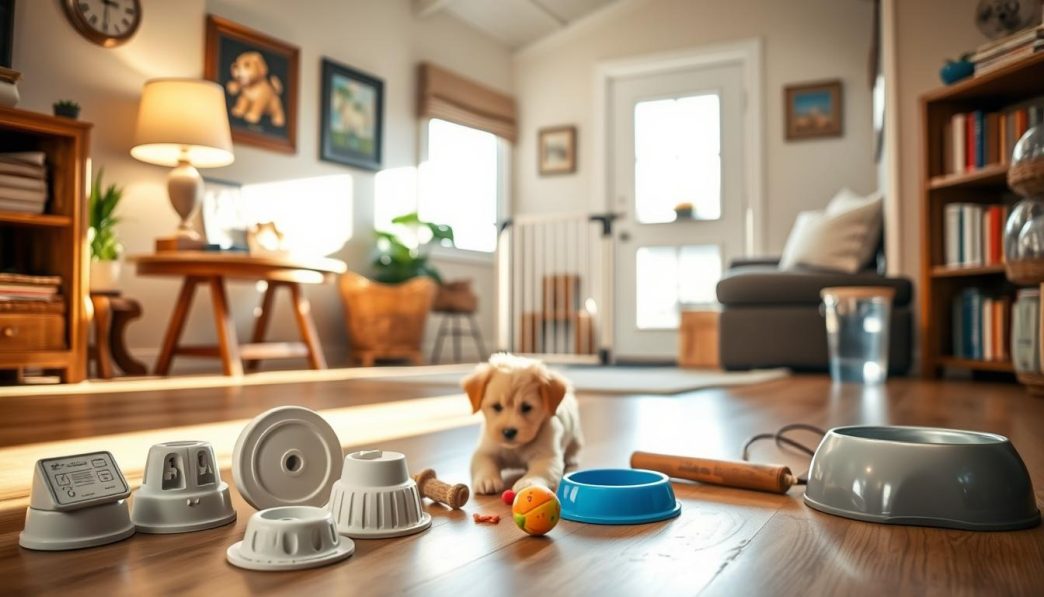Welcoming a new pet into your family can be a thrilling experience. As a new pet parent, it’s essential to ensure your living space is safe and secure for your furry friend to explore and play.
Creating a pet-safe environment involves identifying potential hazards and taking steps to mitigate them. This includes securing toxic substances, electrical cords, and fragile items, as well as setting boundaries to prevent unwanted behaviors.
In this article, we’ll guide you through the process of pet-proofing your home, providing you with valuable pet safety tips to keep your new companion safe and happy.
Key Takeaways
- Identify potential hazards in your home
- Secure toxic substances and electrical cords
- Set boundaries to prevent unwanted behaviors
- Create a safe space for your pet to play and relax
- Supervise your pet at all times to ensure their safety
Understanding the Importance of Pet-Proofing
Creating a safe environment for your pets is not just about love; it’s also about being aware of the potential dangers lurking in your home. As a new pet parent, it’s essential to understand that your home, filled with various hazards, needs to be adapted to ensure your pet’s safety and well-being.
Common Household Dangers for Pets
Pets, especially curious ones, can get into trouble by ingesting toxic substances, chewing on electrical cords, or breaking fragile items. Common household dangers include:
- Toxic substances like cleaning supplies and certain medications
- Electrical cords and outlets
- Sharp objects and fragile items
Being aware of these dangers is the first step towards mitigating them. For instance, securing toxic substances in high cabinets and using cord protectors can significantly reduce risks.
Benefits of a Pet-Safe Environment
A pet-safe environment not only protects your pets but also benefits you as a pet owner. By minimizing hazards, you reduce the stress associated with worrying about your pet’s safety. Moreover, a safe environment can lead to a decrease in potential veterinary bills, as your pet is less likely to suffer from accidents or poisoning.
| Benefits | Description |
|---|---|
| Reduced Stress | Less worry about your pet’s safety |
| Lower Veterinary Bills | Fewer accidents mean less money spent on vet visits |
| Healthier Pets | A safer environment contributes to overall pet health |
Pet-Proofing Your Home: Safety Tips for New Pet Parents
As a new pet parent, it’s essential to transform your home into a safe haven for your furry friend. This involves a thorough assessment of your living space to identify potential hazards and taking steps to mitigate them.
Assessing Your Home Through Your Pet’s Eyes
To effectively pet-proof your home, you need to see it from your pet’s perspective. Get down to their level and observe your home environment. Look for potential dangers such as electrical cords, toxic substances, and unstable furniture.
Consider the following when assessing your home:
- Electrical cords and outlets
- Toxic substances and medications
- Unstable furniture and fixtures
- Small objects that can be swallowed
Creating a Comprehensive Pet-Proofing Checklist
A comprehensive checklist is crucial for ensuring your home is pet-proofed. Start by securing toxic substances and medications out of reach. Use safety latches on cabinets and drawers to prevent access.
| Area | Hazard | Prevention Measure |
|---|---|---|
| Kitchen | Toxic substances, sharp objects | Secure cabinets, lock drawers |
| Living Room | Electrical cords, unstable furniture | Secure cords, stabilize furniture |
| Bathroom | Medications, toiletries | Secure cabinets, lock bathroom door |
By following these steps and creating a comprehensive pet-proofing checklist, you can ensure a safe and happy home for your pet.
Kitchen Safety Measures
Kitchen safety is a critical concern for pet owners, as this space is filled with tempting foods, hazardous chemicals, and potentially dangerous appliances. Ensuring your kitchen is pet-proofed can significantly reduce the risk of accidents and create a safer environment for your pets.
Securing Food and Trash
One of the most challenging aspects of kitchen safety is securing food and trash from pets. Pets are often attracted to the kitchen due to the presence of food, making it essential to store food and trash properly.
Preventing Counter Surfing
To prevent counter surfing, keep your counters clear of food and other tempting items. Use pet-proof containers to store food and keep them out of reach.
Pet-Proof Food Storage Solutions
Invest in secure storage solutions such as locking cabinets or containers with secure lids to prevent pets from accessing food. Consider storing food in high cabinets that pets cannot reach.
Managing Harmful Chemicals and Cleaners
Chemicals and cleaners in the kitchen can be hazardous to pets. Ensure that all cleaning supplies are stored in a secure location out of reach of pets.
| Chemical/Cleaner | Safe Storage Method |
|---|---|
| Dish soap | Locked cabinet |
| All-purpose cleaners | High shelf |
| Pest control | Locked container |
Appliance and Counter Safety
Kitchen appliances and counters can pose significant risks to pets. Implement safety measures to prevent accidents.
Stove and Oven Precautions
Keep stove and oven knobs out of reach of pets, and consider using stove knob covers to prevent accidental ignition.
Small Appliance Management
Keep small appliances such as toasters and blenders unplugged when not in use and store them in a secure location.

By implementing these kitchen safety measures, you can significantly reduce the risk of accidents and create a safer, more enjoyable environment for your pets.
Living Room and Common Areas Protection
As a pet owner, securing your living room and common areas is essential to prevent accidents and damage. These spaces are often where pets and family members spend a lot of time together, making them critical areas to pet-proof.
Furniture and Decor Considerations
Furniture and decor can pose significant risks to pets, from chewing and scratching damage to the potential for heavy items to topple over.
Preventing Chewing and Scratching Damage
To protect your furniture, consider using pet-friendly materials or covers that can withstand scratching. Providing your pets with appropriate alternatives, like scratching posts, can also redirect their behavior away from your furniture.
Securing Heavy Items and Breakables
Ensure that heavy furniture and decorative items are securely anchored to walls to prevent them from tipping over. This not only protects your pets but also your belongings.
Electrical Cord Management
Managing electrical cords is crucial to prevent pets from chewing on them, which can lead to electrical shock or fires. Use cord protectors or secure cords out of reach to mitigate these risks.
- Secure cords behind furniture or use cord clips.
- Keep appliances unplugged when not in use.
- Consider using cordless appliances where possible.
Houseplant Safety and Toxic Plant Alternatives
Many common houseplants are toxic to pets. Opt for pet-safe plants like spider plants or parlor palms. If you have toxic plants, ensure they are out of your pet’s reach.
By implementing these strategies, you can significantly reduce the risks in your living room and common areas, creating a safer, more enjoyable space for both you and your pets.
Bathroom Hazards to Address
Bathrooms are among the most critical areas to pet-proof in your home to ensure your pet’s safety. This space, while necessary and often used, contains several hazards that can be detrimental to your pet’s health.
Medication and Toiletry Storage
One of the primary concerns in the bathroom is the storage of medications and toiletries. Pets are often attracted to the smells and tastes of these products, which can be harmful if ingested.
Safe Medicine Cabinet Organization
To prevent accidental ingestion, it’s crucial to organize your medicine cabinet safely. Keep all medications in a secure, pet-inaccessible location, and consider using child-safety locks if you have particularly curious pets.
Securing Potentially Toxic Products
Many toiletries, such as shampoos, conditioners, and soaps, can be toxic to pets. Ensure these products are stored out of reach, and consider using a locked cabinet or a high shelf to keep them safe.
Toilet and Bathtub Safety
Beyond storage, the toilet and bathtub themselves pose significant risks. Toilet bowls can be attractive to pets who might drink from them or fall in, while bathtubs can be slippery and dangerous, especially when filled with water.
| Hazard | Safety Measure |
|---|---|
| Toilet Water | Keep toilet lids closed |
| Bathtub Slipperiness | Use non-slip mats |
| Medications | Store in a locked cabinet |
By addressing these bathroom hazards, you can significantly reduce the risk of accidents and create a safer environment for your pets.
Bedroom Pet-Proofing Strategies
The bedroom, often considered a sanctuary, requires careful pet-proofing to ensure safety. As a space where pets often spend a significant amount of time, it’s crucial to address potential hazards.
Safe Sleeping Arrangements
Creating a safe sleeping environment for your pet is vital. This includes providing a comfortable, pet-specific bed and ensuring that human bedding is not a hazard. Keep in mind that pets, especially dogs, may prefer to sleep on their owner’s bed, so establishing boundaries is key. Consider using a pet gate or barrier to limit access to certain areas if needed.
“A well-rested pet is a happy pet, but safety should always come first.”
Securing Personal Items and Clothing
Personal items and clothing can pose significant risks to pets. Electrical cords from lamps or phones can be tempting chew toys, and clothing items like socks or underwear can become choking hazards if ingested.
Managing Small Choking Hazards
Small items like jewelry, coins, or buttons can be dangerous if swallowed. Keeping these items out of reach is crucial. Regularly cleaning your bedroom floor and surfaces can significantly reduce the risk of choking hazards.
Protecting Valuables from Curious Pets
Pets, especially cats, may view personal items as toys. Securing valuables and keeping them out of reach can prevent damage and potential ingestion of harmful materials. Consider storing valuable or dangerous items in closed containers or high shelves.
Outdoor and Yard Safety
Your yard can be a wonderful playground for your pet, but it requires careful pet-proofing. Ensuring your outdoor space is safe involves several key measures to protect your pet from potential hazards.
Fence and Boundary Security
A secure fence is essential to prevent your pet from escaping. Inspect your fence regularly for any damage or weak spots.
Escape-Proofing Your Yard
To escape-proof your yard, consider installing a fence that is at least 6 feet tall if you have a large breed dog. For smaller pets, ensure the gaps between the fence slats are narrow enough to prevent squeezing through.
Gate and Door Safety Measures
Gates and doors leading to the yard should be securely locked to prevent accidental openings. Consider installing self-closing and self-latching gates to add an extra layer of security.
Garden and Plant Toxicity
Many common garden plants are toxic to pets. Be aware of the plants in your yard and remove any that could be harmful if ingested.
- Common toxic plants include Azalea, Oleander, and Sago Palm.
- Opt for pet-friendly plants like Sunflowers and Zinnias.
Weather Protection and Outdoor Hazards
Protect your pet from extreme weather conditions by providing adequate shelter. Be mindful of outdoor hazards such as pesticides, sharp objects, and toxic substances that could harm your pet.
During hot weather, ensure your pet has access to shade and plenty of fresh water. In cold weather, provide a warm shelter to protect your pet from hypothermia.
Special Considerations for Different Pets
Ensuring your home is safe for your pet involves understanding the distinct needs of different pets. Whether you have a dog, cat, or small pet, each requires a tailored approach to pet-proofing.
Dog-Specific Safety Concerns
Dogs, especially those that are energetic or curious, require specific safety measures. One of the primary concerns is ensuring that hazardous materials and objects are out of reach.
Breed-Specific Considerations
Different breeds have unique characteristics that may influence their safety needs. For example, larger breeds may need more space and sturdy furniture, while smaller breeds might require protection from being stepped on or trapped under furniture.
Puppy vs. Adult Dog Safety Needs
Puppies are generally more curious and destructive than adult dogs, necessitating extra precautions such as securing electrical cords and toxic substances. Adult dogs, while less destructive, still require a safe environment to prevent accidents.
Cat-Proofing Essentials
Cats are known for their agility and curiosity, often exploring vertical spaces and sharp edges. Cat-proofing involves securing loose items, protecting windows, and creating safe climbing structures.
Vertical Space Safety
Cats love to climb, so ensuring that your home’s vertical spaces are safe is crucial. This can involve securing tall furniture and providing appropriate cat shelves or climbing structures.
Window and Balcony Protection
Windows and balconies can be hazardous for cats, who may fall or get trapped. Installing window guards and securing balconies can prevent such accidents.
Small Pet Considerations
Small pets, such as hamsters, guinea pigs, and rabbits, have their own set of safety needs. Their enclosures should be secure and escape-proof, and they should be kept away from drafts and predators.
Emergency Preparedness for Pet Owners
Ensuring your pet’s safety during emergencies requires careful planning and preparation. As a pet owner, it’s essential to be proactive in creating a safe environment for your pets, not just during daily life but also in the face of unexpected events.

Being prepared involves several key steps, starting with understanding the types of emergencies that could affect your pet, such as natural disasters, medical emergencies, or home hazards. By anticipating these risks, you can take concrete measures to mitigate them.
Creating a Pet First Aid Kit
A crucial element of emergency preparedness is having a well-stocked pet first aid kit. This kit should include essential items such as bandages, antiseptic wipes, tweezers, and any medications your pet may need. It’s also a good idea to include a pet first aid guide to help you respond appropriately in an emergency.
Emergency Contact Information
In the event of an emergency, having readily available contact information for your veterinarian, local animal hospitals, and emergency services can be lifesaving. Make sure this information is easily accessible, whether it’s on a fridge magnet, in your phone, or both.
Evacuation Planning with Pets
An often-overlooked aspect of emergency preparedness is having a clear evacuation plan that includes your pets. Identify safe zones and escape routes, and practice the plan with your pets to ensure they are comfortable with their carriers or leashes. Don’t forget to pack essential supplies like food, water, and your pet first aid kit.
By taking these steps, you can significantly enhance your pet’s safety and well-being during emergencies. Remember, preparation is key to ensuring that you and your pets can navigate unexpected situations with confidence.
Conclusion: Creating a Safe and Happy Home for Your Pet
Pet-proofing your home is a multifaceted process that requires attention to various areas, from the kitchen and living room to outdoor spaces and bedrooms. By implementing the safety tips and strategies outlined in this article, new pet parents can create a happy home where their pets can thrive.
A pet-safe environment not only protects your pets from harm but also promotes a harmonious and healthy coexistence. By assessing your home through your pet’s eyes and creating a comprehensive pet-proofing checklist, you can identify potential hazards and take proactive steps to mitigate them.
As you’ve learned, different areas of your home pose unique risks to your pets. By securing food and trash, managing harmful chemicals, and protecting electrical cords, you can significantly reduce the risk of accidents. Additionally, being mindful of your pet’s specific needs, whether it’s a dog, cat, or small pet, will help you tailor your pet-proofing efforts for maximum effectiveness.
By following these guidelines and staying committed to pet safety, you can create a haven where your pets feel safe, happy, and loved. This not only enhances their well-being but also strengthens the bond between you and your pets, leading to a more fulfilling and joyful experience for both.






